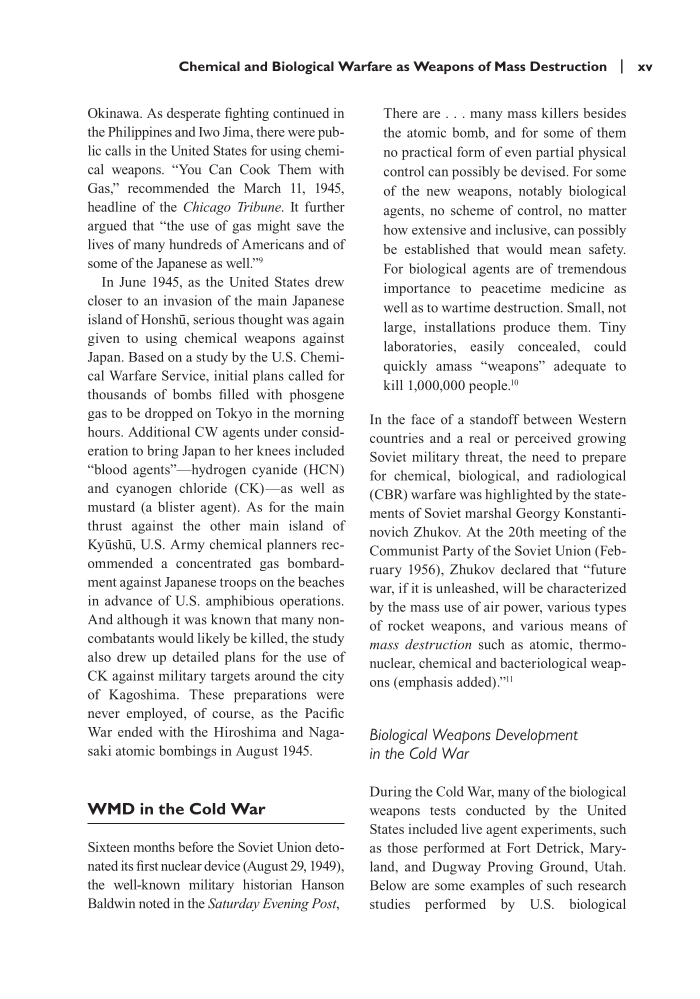Chemical and Biological Warfare as Weapons of Mass Destruction | xv Okinawa. As desperate fighting continued in the Philippines and Iwo Jima, there were pub- lic calls in the United States for using chemi- cal weapons. “You Can Cook Them with Gas,” recommended the March 11, 1945, headline of the Chicago Tribune. It further argued that “the use of gas might save the lives of many hundreds of Americans and of some of the Japanese as well.”9 In June 1945, as the United States drew closer to an invasion of the main Japanese island of Honshu¯, serious thought was again given to using chemical weapons against Japan. Based on a study by the U.S. Chemi- cal Warfare Service, initial plans called for thousands of bombs filled with phosgene gas to be dropped on Tokyo in the morning hours. Additional CW agents under consid- eration to bring Japan to her knees included “blood agents”—hydrogen cyanide (HCN) and cyanogen chloride (CK)—as well as mustard (a blister agent). As for the main thrust against the other main island of Kyu¯shu¯, U.S. Army chemical planners rec- ommended a concentrated gas bombard- ment against Japanese troops on the beaches in advance of U.S. amphibious operations. And although it was known that many non- combatants would likely be killed, the study also drew up detailed plans for the use of CK against military targets around the city of Kagoshima. These preparations were never employed, of course, as the Pacific War ended with the Hiroshima and Naga- saki atomic bombings in August 1945. WMD in the Cold War Sixteen months before the Soviet Union deto- nated its first nuclear device (August 29, 1949), the well-known military historian Hanson Baldwin noted in the Saturday Evening Post, There are . . . many mass killers besides the atomic bomb, and for some of them no practical form of even partial physical control can possibly be devised. For some of the new weapons, notably biological agents, no scheme of control, no matter how extensive and inclusive, can possibly be established that would mean safety. For biological agents are of tremendous importance to peacetime medicine as well as to wartime destruction. Small, not large, installations produce them. Tiny laboratories, easily concealed, could quickly amass “weapons” adequate to kill 1,000,000 people.10 In the face of a standoff between Western countries and a real or perceived growing Soviet military threat, the need to prepare for chemical, biological, and radiological (CBR) warfare was highlighted by the state- ments of Soviet marshal Georgy Konstanti- novich Zhukov. At the 20th meeting of the Communist Party of the Soviet Union (Feb- ruary 1956), Zhukov declared that “future war, if it is unleashed, will be characterized by the mass use of air power, various types of rocket weapons, and various means of mass destruction such as atomic, thermo- nuclear, chemical and bacteriological weap- ons (emphasis added).”11 Biological Weapons Development in the Cold War During the Cold War, many of the biological weapons tests conducted by the United States included live agent experiments, such as those performed at Fort Detrick, Mary- land, and Dugway Proving Ground, Utah. Below are some examples of such research studies performed by U.S. biological
Document Details My Account Print multiple pages
Print
You have printed 0 times in the last 24 hours.
Your print count will reset on at .
You may print 0 more time(s) before then.
You may print a maximum of 0 pages at a time.




































































































































































































































































































































































































